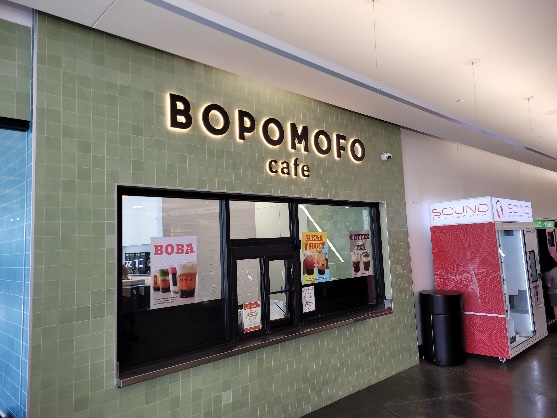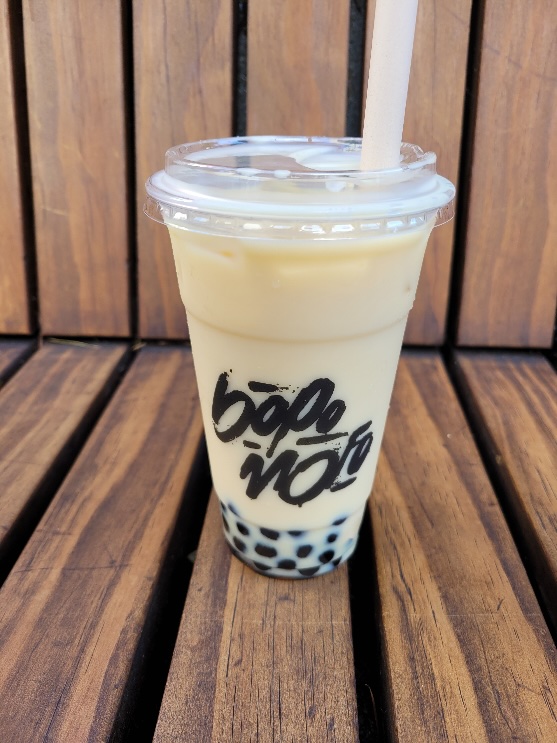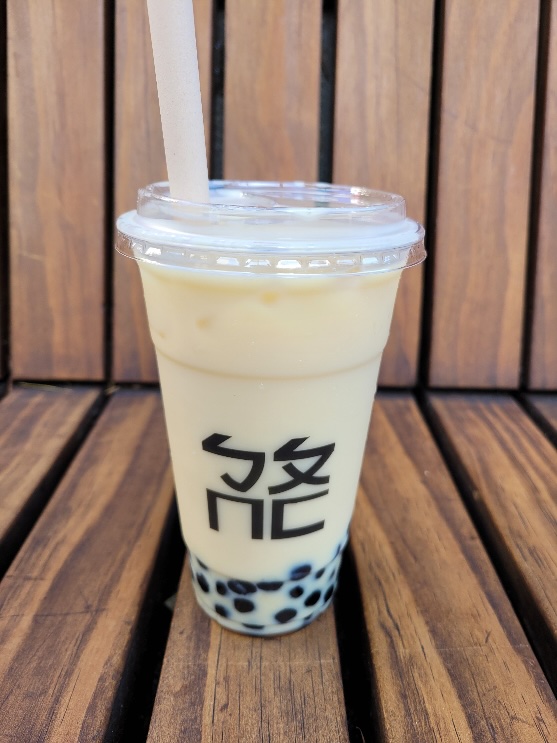Bopomofo Cafe
« previous post | next post »
Chris Button saw this bubble tea place at 3:45 PM today in Hollywood:
From the cafe's website:
BOPOMOFO CAFE draws its name from the phonetic Traditional Chinese Alphabets. ㄅ, ㄆ, ㄇ, and ㄈ [bo, po, mo, and fo] are the “ABCs” of the Mandarin Chinese alphabet symbolizing nostalgia and strength as the building blocks of Mandarin language mastery. Co-founders Eric and Philip, both "American Born Chinese" (ABC), chose the name to reflect their heritage and shared pride in their culture.
Chris ended up going inside. The branding on the cups is clever. They've made the shapes of the b, p, m, f look like the shapes of the zhuyin.
- "Bopomofo vs. Pinyin" (4/26/15)
- "Another use for Mandarin Phonetic Symbols" (3/29/18)
- "The end of the line for Mandarin Phonetic Symbols?" (3/12/18)
- "Fangyán = topolect in DC" (6/20/23)
- "Impromptu biscriptalism on a Starbucks cup" (9/8/17)
- "Biscriptalism on Starbucks cups, part 2" (9/16/17)
[Thanks to Ben Zimmer]



Gabriel Carroll said,
June 20, 2025 @ 9:45 am
Thematically related, here in Toronto there's an Abugida Restaurant: https://abugidatoronto.wordpress.com/
David Marjanović said,
June 20, 2025 @ 12:18 pm
This somehow made me think of a tune… and then I remembered the tune belongs to this Traditional Mongolian alphabet song. Well, syllabary song, because the script is taught as a syllabary.
Chas Belov said,
June 20, 2025 @ 1:55 pm
"Bopomofo" also occurs in a Cantopop song by the late Danny Chan, which I can't seem to find online or remember the title for, which is tri-lingual in Cantonese, Mandarin, and English (plus a mention of the Alliance française), where he sings about learning Mandarin.
Chas Belov said,
June 20, 2025 @ 2:40 pm
And just remembering that song has the overcorrection of "ngoi" for "oi," love.
Ngoh ngoi neih
Yingyu tung Gwongdungwa
[something] [something] tung Putonghua
Mingbaak daaiga
Neih hou ma
My gloss:
I love you
English and Cantonese
[something] [something] and Mandarin
I understand them all
Hello
although I find the "ma" odd for Cantonese, expecting "Neih hóu?" or "Neih hóu m̀h hóu?"
amy said,
June 21, 2025 @ 9:28 pm
No doubt the branding with "mofo" on a separate line was meant to evoke something different, more vulgar, but just as memorable to those who aren't familiar with Chinese.
Chris Button said,
June 21, 2025 @ 11:46 pm
@ amy
Thanks for bringing that up.
I think the branding is really clever (disclaimer: I worked in branding/advertising for several years early in my career).
To those who know what the name means, the name evokes legitimacy and authenticity. And the clever lettering on the cup then adds to that. The product then lives up to the name. By the way, the store facade is also much nicer than the pickup window I shared in the photo above (the image had no people in it, so I felt it was more appropriate to share here)
To those who don't know what the name means, the name certainly has a ring to it! The "mofo" part no doubt helps, but they certainly aren't pushing it. Bopomofo is spelled out horizontally in the store in English and in zhuyin, and only the cups separate "mofo" off. And yet the graffiti-style English lettering (again only on the cups) does make it a little edgy at the same time.
Scott P. said,
June 22, 2025 @ 8:05 am
I'm curious about the line break on the cups. Surely the cups should either read "bopo-mofo" or the main sign should read "bopo mofo". Which would be correct?
KC said,
June 23, 2025 @ 9:43 am
@Scott P.
Bopomofo as a term is considered a singular phrase, just as you wouldn't say "AB-C" or "AB C" to describe the concept of the initial letters of the Latin alphabet.
I think the line break on the cups are just a stylistic decision that mirrors the ㄅㄆㄇㄈ design. That ㄅㄆ/ㄇㄈ "line break", as it exists, doesn't really signify anything as it's traditionally common to fit Chinese characters into a square as a design, as in a seal.
@Chas Belov
"Neih hou ma" is probably just mirroring the Mandarin Ni Hao Ma, just deliberately saying out in Cantonese a classic Mandarinism, like one might use an English pronunciation to say "Hola mee yammo KC como estass" to evoke the experience to learning Spanish in grade school.
Fen Yik said,
June 23, 2025 @ 3:32 pm
@Chas Belov – the song is《南北一家親》: https://www.youtube.com/watch?v=wlaoyjbqrTE
Interestingly, the Cantonese part of the chorus has 我嗌你 'I call to you' in the same spot as 我愛你 'I love you' in the Mandarin part. Cantonese 嗌 (ng)aai3 'call/yell' is phonetically more similar to Mandarin 愛 ài 'love' than Cantonese 愛 (ng)oi3 would be, so it's a reasonable choice.
Chas Belov said,
June 23, 2025 @ 6:51 pm
@Fen Yik, ¡yes, that's the song! ¡唔該哂!
Chas Belov said,
June 23, 2025 @ 7:00 pm
@Fen Yik, apologies if 多謝哂 would have been more appropriate, since I didn't specifically ask for help locating the song.
In the original audio version at https://youtu.be/qxV8r9MTC7w, I believe the chorus background is saying "ngoh ngōi néih" as expected. My Cantonese is dreadful, so I could be mistaken. Well, I suppose "ngoh ōi néih" would be expected, with "ngôi" as the hypercorrection.
Chas Belov said,
June 23, 2025 @ 7:08 pm
For the record, I was once corrected to 多謝 by a waiter for saying 唔該 when they comped me a cup of soup.
Fen Yik said,
June 23, 2025 @ 11:05 pm
@Chas Belov, 唔使客氣! And thanks for sharing the original audio version. Sorry to disagree, but I'm still hearing 嗌 ngaai and not 愛 ngoi there. For the record, though, I spent more time in Canada than in Hong Kong growing up, and my English is a lot better than my Cantonese, even though I learned Cantonese first chronologically.
I understand their desire to correct in the soup situation. If they'd just let the 唔該 slide, they might've lost some credit for their generosity in comping you. :)